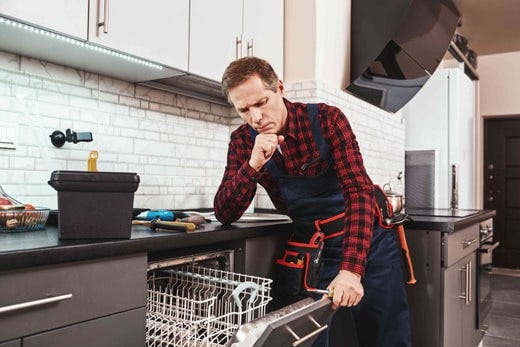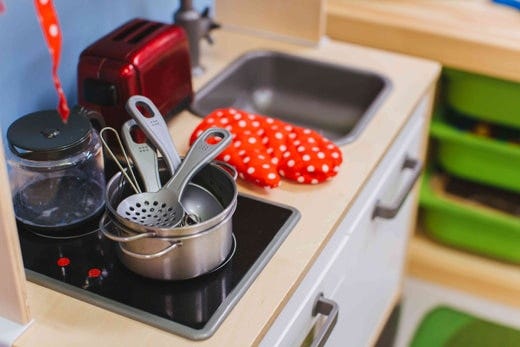
How to Install a Dishwasher: Step-By-Step Guide

Whether you are upgrading an existing dishwasher or adding a new one, installing a dishwasher is a practical and rewarding home improvement project that helps you save time, effort, and money by being energy efficient.
Now, we understand that, like with any other appliance, installing a new dishwasher can seem daunting if you are unfamiliar with the process and instructions. But don't worry—we've got your back!
In this comprehensive “how to install a dishwasher” guide, we'll walk you through each stage of installation to ensure it all goes smoothly and make dishwashing a breeze!
Before you begin
Before installing a dishwasher, ensure you have a water line, a draining line, and a power cord in place. Also, verify that there are no preexisting utility connections within your cabinet opening.
1. Power connection
Locate the wire connection enclosure, usually covered, which you'll need to uncover. Your dishwasher includes a power cord; insert the end not meant for the outlet into this housing.
Match the wires by color (e.g., green to green, white to white, black to black). Once connected, replace the cover of the wire housing. Guide the cord under your sink and plug it into the outlet.
2. Water supply
Connecting the water supply is straightforward. A braided steel supply tube links one end to the dishwasher's water inlet valve and the other to a shut-off valve on a hot-water supply pipe.
This tube is an elongated version of those found on sink faucets and toilets, which will be familiar if you've dealt with those plumbing fixtures.
To connect the water supply tube to the dishwasher, you'll typically use a specialized brass fitting called a "dishwasher 90." This 90-degree elbow facilitates an easy connection between the supply tube and the dishwasher. The fitting, along with the braided steel supply tube, is typically included in the connection kit.
3. Drain hose
Lastly, if your dishwasher hasn't been connected yet, attach the drain hose. Guide the drain hose from the dishwasher through the cabinet hole.
Connect it to either the sink tailpipe or the garbage disposal unit. Adhere closely to the manufacturer's guidelines, as you might have to create a loop in the hose for an air gap. This prevents dirty water from flowing back into the dishwasher.
How to install a dishwasher?
Here's everything you need to know to install a dishwasher in your kitchen in step-by-step order.
1. Identify the access panel
The electrical and plumbing connections are behind an access panel at the dishwasher's front bottom.
- To access these, lay the dishwasher on its back and remove the bottom access panel. This will allow you to make the initial connections.
- Once the panel is removed, visually locate the power cord connection fittings, the water inlet solenoid valve, and the drain fitting.
2. Attach the electric cord
- Take off the cover from the wire connection enclosure.
- Insert the power cord into the enclosure and secure three wire connections: attach the green wire from the appliance cord to the green grounding screw, connect the white neutral wire to the white dishwasher lead, and join the black hot wire to the black dishwasher lead. Use twist-on wire connectors (wire nuts) for these connections.
- Put the cover back onto the wire connection enclosure.
3. Hook up the water supply
Your dishwasher connector kit includes a dishwasher 90, which is essential for linking the water supply to your dishwasher.
- First, find the water inlet fitting on the solenoid valve.
- Apply pipe joint compound to the threads of the dishwasher 90 fitting, then screw it onto the solenoid valve.
- Hand-tighten it fully, and then give it an extra 1/4 turn using channel-lock pliers or an adjustable wrench.
4. Attach water supply line
The dishwasher connector kit contains a braided steel water supply tube.
- Attach the supply tube coupling nut to the dishwasher 90 fitting and secure it using channel-lock pliers or an adjustable wrench. Do not overtighten to avoid stripping the threads.
- This is a compression fitting and doesn't need a pipe joint compound.
5. Position the dishwasher
- Flip the dishwasher back upright.
- Position the dishwasher beneath the kitchen counter, guiding the power cord, water supply tube, and drain hose through the cabinet's sidewall holes. Align the appliance centrally within the opening, avoiding pushing it too far back.
- Utilize the adjustable legs to elevate and level the dishwasher according to the manufacturer's guidelines. If needed, use pliers to unscrew the legs and adjust their height until the dishwasher reaches counter height and is level.
6. Anchor the dishwasher
- Once you're satisfied with the dishwasher's position, you can secure it by opening the door and accessing the mounting brackets.
- Utilize the supplied screws to attach the brackets to the cabinet frame, positioning them under the counter's lip.
7. Connect the water supply tube
- Link the water supply tube's end to the water supply shutoff valve located under the kitchen sink. (For a new setup, you might have to install this shutoff valve on the hot water pipe.)
- Open the shutoff valve.
- Inspect for leaks by examining under the dishwasher and at the opposite end of the supply tube connected to the dishwasher 90 fittings.
- If any leaks are spotted at either spot, carefully tighten the fittings slightly more.
8. Connect the drain hose
- The dishwasher's rubber drain hose is typically pre-attached. If not, secure it using a hose clamp at this stage.
- Various configurations for the drain hose exist, depending on your sink setup and local code regulations.
1. Air-gap fitting
You can connect the dishwasher drain hose to an air-gap fitting fixed on the countertop or sink deck. Another hose extends to either the garbage disposal or the sink drain tailpiece.
Typically, the dishwasher hose links to the air gap using a spring clip and connects to the garbage disposal using a hose clamp.
2. High-loop connection
You can create a "high loop" with the dishwasher drain hose by looping it up and fastening it to the underside of the countertop before dropping it down to connect to the garbage disposal or sink drain tailpiece.
This setup mimics an air gap, which stops water from flowing back. However, local codes may not permit this approach.
9. Test the dishwasher
- Connect the dishwasher's power cord to an outlet.
- Prior to reattaching the front faceplate, conduct a test by running a complete cycle to verify proper functioning.
- Check that the dishwasher is receiving fresh water and draining correctly without leaks.
- Lastly, reattach the front faceplate to the bottom front of the dishwasher.
.png?width=70&height=45&format=png&quality=50)


